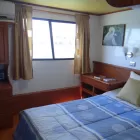- Ship
- 1 Breakfast, 1 Lunch, 1 Dinner
Española belongs to the oldest islands of the Galapagos. Because of its geographic isolation, many endemic species are to find the island, making the visit especially attractive. Additionally, Española is the only place worldwide where the endemic waved albatrosses come for breeding from April to December.
Wet landing on Playa Gardner, a splendid, long, white beach of coral sand. For this visit, you do not need shoes. There is no trail, and the open beach offers the opportunity to observe finches and mockingbirds in the saltbush vegetation, as Galapagos sea lions sleeping in the sun. It is an excellent place for swimming and snorkeling from the beach!
Activities: Hiking, Snorkeling
Punta Suarez: Loop trail with a smooth, dry landing on a jetty. The walk on stony, rocky ground is longer and more challenging. Even at the first steps of the trail, the colorful Española marine iguana and Galapagos sea lions welcome you. Everywhere the curious Española mockingbird approaches the visitors. The path leads through the nesting colonies of blue-footed boobies, Nazca boobies, and waved albatrosses. Also, the big Española lava lizards are to find everywhere.
Activities: Hiking
The low cliff of the whole south coast is an ideal nesting place for the endemic Galapagos albatross; here, it is the only place in the world where, from April to December, you can see these big, beautiful birds. Then, another resting spot close to a cliff with an incredible landscape offers the observation of all the different marine birds flying along the coast. An albatross during his ungainly landing or the spectacular take-off from the cliff, to start its elegant flight, are fantastic events to witness. The next stop is at the blowhole: the waves push the seawater through a fissure in the cliff, depending on the strongness and tide level, till 80 feet/24m high in the air!

















